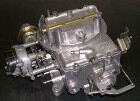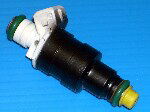Automotive Definitions
- Atomized
- A super fine mixture that appears to be smoke. Efficiently atomized gasoline looks like a white smoke but is highly volatile.
- Barrel
- The bore or venturi(s) of a throttle body or carburetor. It is the cavity where the incoming air enters the carburetor. There are 1, 2, 3, and 4 barrel carburetors, typically.
- Base Plate
- The base plate is usually the lower most housing containing the throttle shaft(s) and blades.
- Carburetor
- A device that mixes fuel with air to create an atomized mixture to be burned in a combustion chamber.
Common Misspellings: carberator, carborator, carbonator, karburetor.
- Catalytic Converter
- A device that looks like a muffler, but contains specially designed materials that convert certain exhaust pollutants into less harmful products. What actually happens is that there is a chemical reaction which creates heat and, in a sense, reburns certain pollutants.
- Choke
- A feature of a carburetor that provides extra fuel for cold starting purposes.
- Combustion Chamber
- The area above the piston when it is at the top of its stroke. Usually this is part of the cylinder head. This pocket is where the combustible mixture is ignited.
- EGR
- Short for: Exhaust Gas Recirculation. An EGR controls combustion temperatures. An engine's exhaust lacks oxygen. Under certain conditions, the combustion chamber and the combusted charge temperature becomes too hot, creating a pollutant called "nitrogens of oxide" (NOX). By injecting some exhaust into the incoming fuel mixture, the combustion temperature is reduced because of its lack of oxygen (inert gas). The volume of exhaust displaces some of the oxygen in the air/fuel mixture in an engineered metering process. One of the exhaust's components is carbon dioxide, which is also used in some fire extinguishers.
- Feedback
- The action of a fuel system where the system sends a determined volume of fuel and/or air to an engine, and then, after it is burned receives a measured signal sent by an oxygen sensor. The signal is processed electronically to determine whether the fuel was insufficient (lean) or excessive (rich). Upon receipt of that signal, a corrected electrical command (pulse) is sent to the carburetor or fuel injector to either add or limit the next fuel volume (mixture).
- Float Bowl
- The reservoir within a carburetor that houses the float. It works just like your toilet tank.
- Fuel Injector
- A valve-like device that opens and closes to regulate a certain volume of fuel and disperses it in a stream, spray, or mist.
- Gasket
- A flat or formed item made of paper, cork, rubber, aluminum, nylon, or copper material, that is used to provide a seal between two parts.
- Governer
- A system to control the throttle at an engineered position to maintain or limit the engine speed.
- Heli-Coil
- A spiral-wound, but thread-shaped metal wire manufactured to screw into a special oversize threaded hole to replace a damaged threaded hole. Usually made of a high-quality metal.
- Linkage
- Linkage is the mechanical connection piece that is between two levers or shaft levers. It is the "link" that joins two pieces to form a mechanism which performs a particular function.
- Manifold
- A housing through which either air, an air/fuel mixture, or exhaust is distributed to or collected from the engine intake or exhaust ports.
- NOX
- Nitrogens of Oxide – A harmful chemical compound which is a product of the exhaust when combustion temperatures are high.
- Oxygen Sensor
- A sensor that samples oxygen content in the exhaust system.
- Piston
- A cylindrical piece of metal that moves within a hollow cylinder or sleeve. Upon combustion, the expanding gas forces the piston downward to complete the combustion stroke.
- TBI Unit
- A Throttle Body Injector Unit looks somewhat like a carburetor but houses one or more fuel injectors. The fuel is sprayed out the bottom of the TBI unit, mixing with the air that is drawn through the top of the unit similar to a carburetor.
- Thermoquad
- A type of carburetor designed to be thermally cooler. Made of a phenolic plastic, the fuel bowl keeps the fuel cooler, resulting in more power and keeping the fuel stable in hot environments. An excellent carburetor.
- Throttle Shaft
- A shaft that runs through the throttle body housing of a carburetor or TBI Unit. Within the throttle bores, the throttle blades are attached to the shaft. The blades act like valves, controlling the volume of the air/fuel mixture passing through the bores. On the outside of the throttle body, the throttle linkage from the gas pedal attaches to the throttle shaft lever to move the throttle. When you step on the gas pedal you are, in effect, rotating the throttle shaft which moves the throttle blades.
- Vacuum Secondary
- The most misunderstood method of opening the secondary throttle valves. The "vacuum" used is created by the column of air rushing past a venturi which creates a negative pressure. This negative pressure is channeled to a diaphragm which creates movement that is mechanically connected to the secondary throttle. That is how a carburetor, on an engine registering zero manifold vacuum on a typical gauge, can open the throttle with negative pressure (vacuum).
- Vapor-Lock
- A phenomena that occurs when excessively hot fuel turns to vapor (boils). Carburetors and fuel pumps are designed to flow or control gasoline in a liquid form only, not in a vapor form. Strangely enough, the carburetor converts the liquid gasoline into an atomized mixture which becomes a vapor but at a lower temperature, hopefully, than the boiling point of gasoline. It accomplishes this by pressure differential. (Creates a negative pressure (vacuum) that can lower the boiling point artificially).
- Variable Venturi
- The venturi on most carburetors is fixed, however on variable venturi carburetors the size of the venturi changes either manually via linkage or by venturi pressure (negative pressure or "vacuum"). This pressure is not manifold vacuum but is created or optimized by the position of the venturi. The "vacuum" used is created by the column of air rushing past a venturi which creates a negative pressure. This negative pressure is channeled to a diaphragm and/or chamber which creates movement that is mechanically connected to the moveable venturi. The moveable venturi itself is either a round
piston in the carburetor bore or a swinging-sliding valve in the bore. Commonly found on motorcycles, some Toyota cars, and some Fords. When tuned and/or designed correctly, the throttle response can be exceptional.
* Check our carburetor and product stock by visiting our store! *
|


